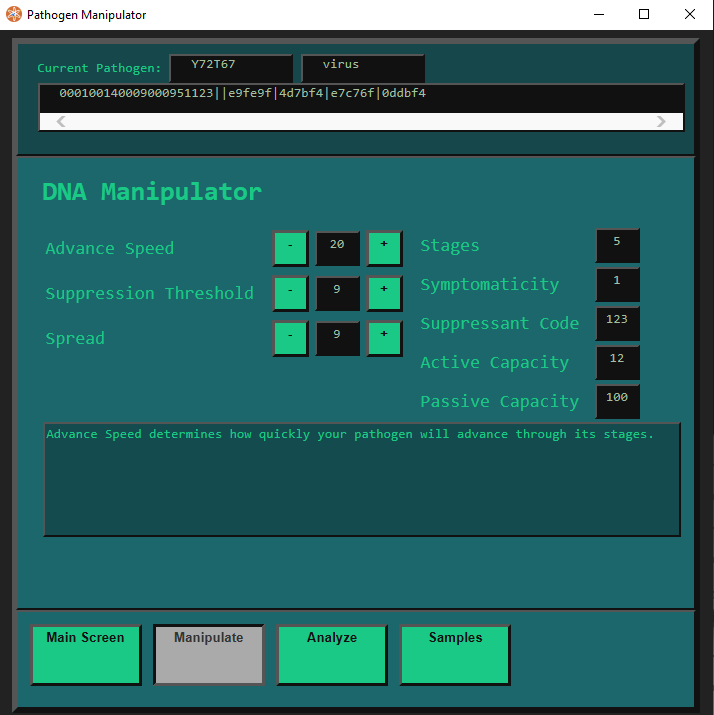Difference between revisions of "User:Zjdtmkhzt/PathologyGarbage"
(→Stats) |
|||
| Line 12: | Line 12: | ||
[[File: | [[File:Patho manip.PNG|none|frame|The Manipulate tab in the Pathogen Manipulator, used to change a pathogens stats.]] | ||
== Microbody Type == | == Microbody Type == | ||
Revision as of 02:23, 21 November 2020
A pathogen is a disease that can have many different effects. These are combined together by a pathologist, so each pathogen you encounter will likely be unique.
A pathogen is defined by several things:
Stats
These are numerical values between 0 and 50 that influence how well the pathogen can do certain things. A pathologist can set these stats directly in the Pathogen Manipulator.
- Advance Rate: This determines how quickly the pathogen will advance through its Stages. (It will also determine how quickly it goes down through the stages under some circumstances.) More on Stages later.
- Spread: This determines how well the pathogen will spread from person to person. This also depends on the pathogens Symptoms. More on Symptoms later. A pathogen with 0 spread will not spread naturally.
- Suppression Threshold: This determines how easily a pathogen can be suppressed via its Suppressant. More on Suppressants later.
A pathogen has only a limited amount of points to spread over these stats, so if it is very good in some stats, the other stats will probably be lower to compensate.
Microbody Type
The specific type of pathogen. There are four different types (plus a fifth that only occurs when the admins bombard the station with diseased burgles).
A specific sample has a specific type, and it is unchangeable, so you will need to find a sample with the type you want and then build off of that for your disease.
The microbody type influence a handful of things:
- Stages: The maximum stage that the pathogen can reach. More on stages later.
- Maximum Sequence Length: This determines how many symptoms (and of what length) the pathogen can support. Adding any more will destroy the pathogen. More on symptoms later.
- Activity: How often the pathogen can trigger its symptoms. This also differs depending on the pathogens stage.
- Growth Medium: What type of Growth Medium needs to be added to a petri dish in order for the pathogen to grow. This is a chemical.
- Anti-Agent: What type of Anti-Agent needs to be used to make a cure in the Synth-O-Matic. This is a chemical.
- Vaccinable: If a Vaccine can be made for the pathogen.
- Auto-Immunization: If you are immune to the pathogen after you have been cured of it once.
Here are the different microbody types:
| Microbody | Stages | Activity | Max. Seq. Len. | Growth medium | Anti-agent | Vaccinable | Self- immunization |
Admin-only |
|---|---|---|---|---|---|---|---|---|
| Virus | 5 | 1, 5, 20, 30, 40 | 12 | Egg | Antiviral Agent | Yes | Yes | No |
| Parasite | 5 | 50, 40, 30, 20, 10 | 18 | Parasitic Medium | Biocide | No | No | No |
| Bacterium | 3 | 30, 30, 30 | 25 | Bacterial Medium | Spaceacillin | Yes | Yes | No |
| Fungus | 1 | 10 | ∞ | Fungal Medium | Biocide | Yes | No | No |
| Great Mutatis | 5 | 20, 20, 20, 20, 20 | ∞ | Stable Mutagen | Mutation Inhibitor | No | No | Yes |
For instance, lets say you are infected by a virus. It starts out in stage 1 (as all infections do). While in stage 1, it will only have a 1% chance to trigger it's symptoms, which is very low! But as it progresses through the stages, it will trigger more and more, with up to a 40% chance to possibly trigger symptoms at stage 5.
Something like a Parasite, on the other hand, will start out at 40% in stage 1, so it might spread very quickly! But as it progresses through the stages, it will trigger a bit less (though still a fair amount). This can be helpful for diseases meant to spread quickly, or that have symptoms where it doesn't really matter how much they trigger, because they mainly have passive effects.
A bacterium has a constant activity, so it always triggers at an ok rate, but it can only progress up to stage 3. This means that the symptoms will be a bit weaker, and some really strong effects may never be able to trigger (stuff like gibbing from tier 5 symptoms, for instance). The main advantage of the bacterium though, is that it you can put a lot more symptoms on it than on a virus or parasite, so you might want to go for it if you want a wide variety of effects that are maybe a bit weaker.
Now, you may be thinking, hold on, the fungus is complete garbage! You are correct, the main purpose of a fungus is for it to be used to cultivate lots of symptoms on it, even if you never intend to actually infect anyone with the fungus. You will see what this comes in handy for later, in the section on how to find new symptoms!
